2009 Hyundai Santa Fe wheel
[x] Cancel search: wheelPage 163 of 269
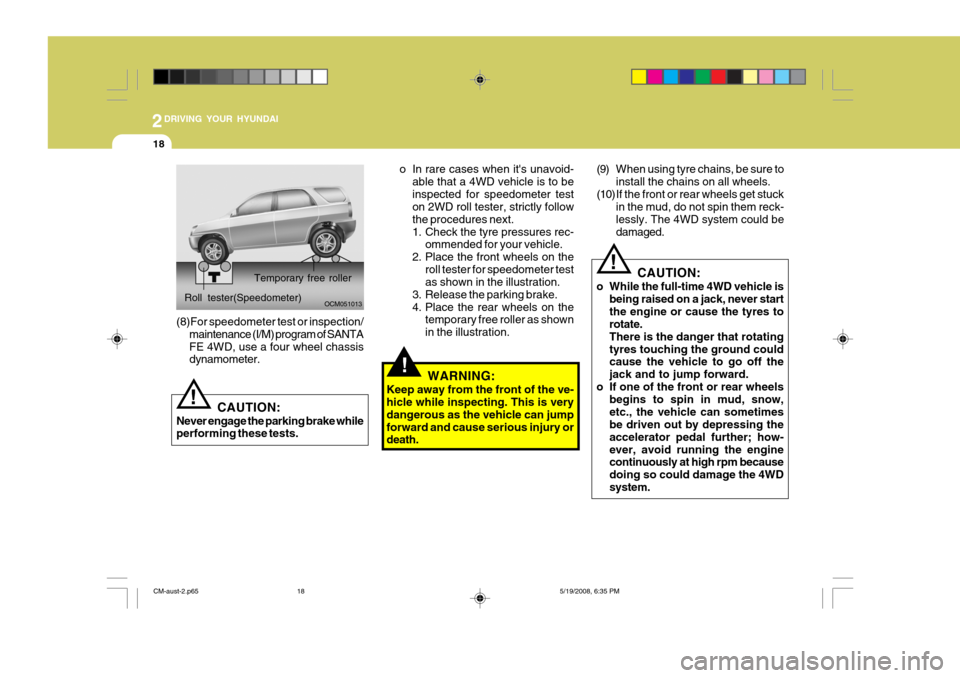
2DRIVING YOUR HYUNDAI
18
!
(9) When using tyre chains, be sure to
install the chains on all wheels.
(10) If the front or rear wheels get stuck
in the mud, do not spin them reck- lessly. The 4WD system could bedamaged.
CAUTION:
o While the full-time 4WD vehicle is being raised on a jack, never startthe engine or cause the tyres torotate.There is the danger that rotatingtyres touching the ground could cause the vehicle to go off the jack and to jump forward.
o If one of the front or rear wheels begins to spin in mud, snow,etc., the vehicle can sometimes be driven out by depressing the accelerator pedal further; how-ever, avoid running the engine continuously at high rpm because doing so could damage the 4WDsystem.
!
WARNING:
Keep away from the front of the ve- hicle while inspecting. This is very dangerous as the vehicle can jumpforward and cause serious injury or death. o In rare cases when it's unavoid-
able that a 4WD vehicle is to be inspected for speedometer test on 2WD roll tester, strictly follow the procedures next.
1. Check the tyre pressures rec-ommended for your vehicle.
2. Place the front wheels on the
roll tester for speedometer test as shown in the illustration.
3. Release the parking brake.
4. Place the rear wheels on the temporary free roller as shownin the illustration.
Roll tester(Speedometer)
(8)For speedometer test or inspection/ maintenance (I/M) program of SANTA FE 4WD, use a four wheel chassis dynamometer.
CAUTION:
Never engage the parking brake whileperforming these tests.
! OCM051013
Temporary free roller
CM-aust-2.p65
5/19/2008, 6:35 PM
18
Page 164 of 269
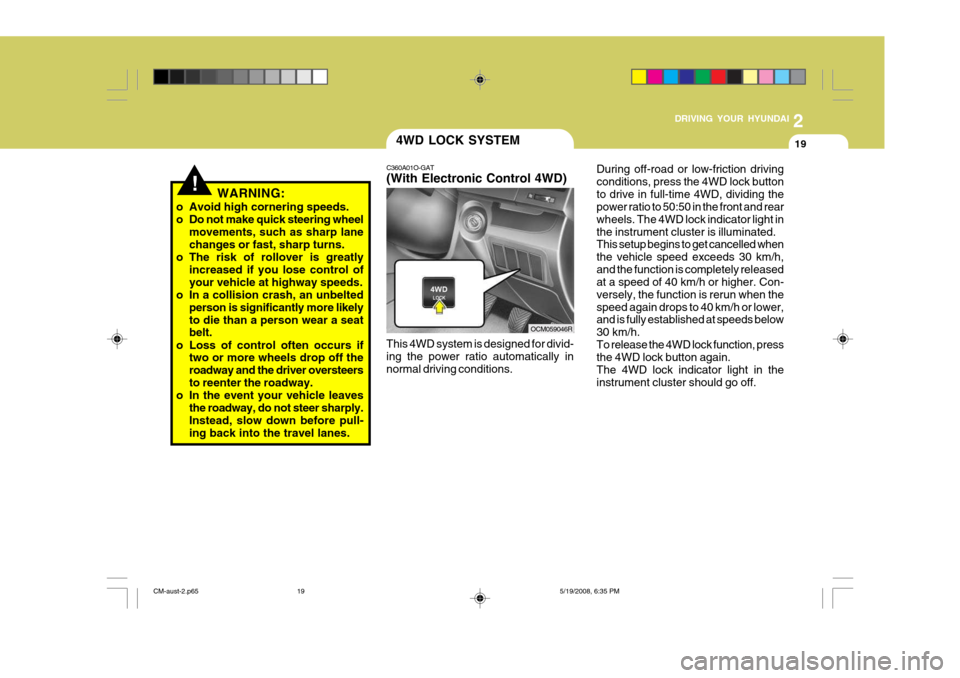
2
DRIVING YOUR HYUNDAI
19
!
4WD LOCK SYSTEM
C360A01O-GAT (With Electronic Control 4WD) This 4WD system is designed for divid- ing the power ratio automatically innormal driving conditions. During off-road or low-friction drivingconditions, press the 4WD lock buttonto drive in full-time 4WD, dividing the power ratio to 50:50 in the front and rear wheels. The 4WD lock indicator light inthe instrument cluster is illuminated. This setup begins to get cancelled when the vehicle speed exceeds 30 km/h,and the function is completely released at a speed of 40 km/h or higher. Con- versely, the function is rerun when thespeed again drops to 40 km/h or lower, and is fully established at speeds below 30 km/h.To release the 4WD lock function, press the 4WD lock button again. The 4WD lock indicator light in theinstrument cluster should go off.
OCM059046R
WARNING:
o Avoid high cornering speeds.
o Do not make quick steering wheel movements, such as sharp lane changes or fast, sharp turns.
o The risk of rollover is greatly increased if you lose control ofyour vehicle at highway speeds.
o In a collision crash, an unbelted person is significantly more likelyto die than a person wear a seat belt.
o Loss of control often occurs if two or more wheels drop off the roadway and the driver oversteersto reenter the roadway.
o In the event your vehicle leaves the roadway, do not steer sharply. Instead, slow down before pull- ing back into the travel lanes.
CM-aust-2.p65 5/19/2008, 6:35 PM
19
Page 166 of 269
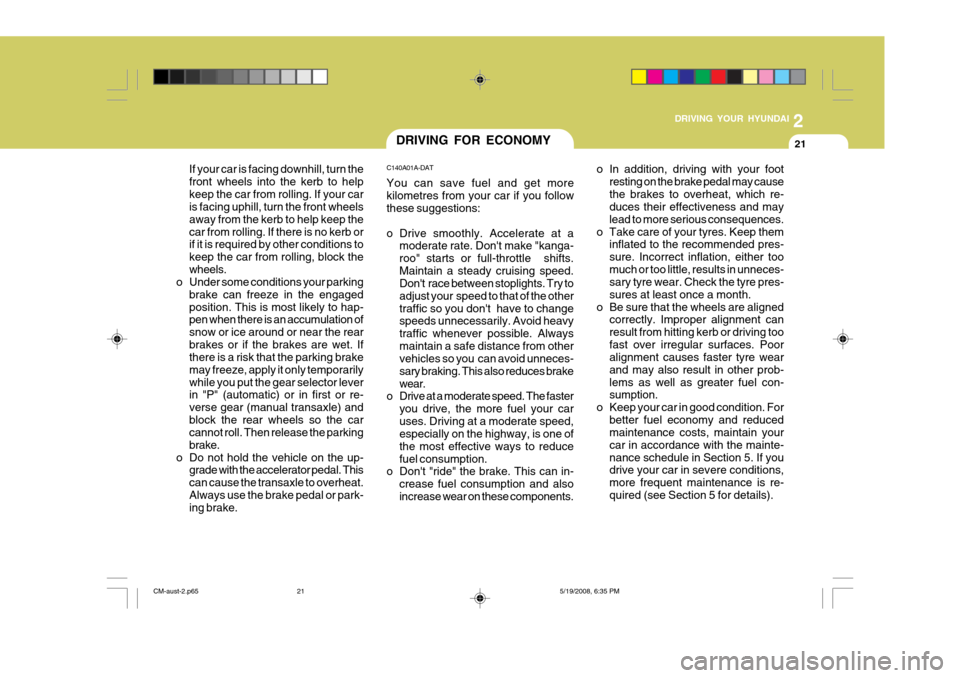
2
DRIVING YOUR HYUNDAI
21
If your car is facing downhill, turn the front wheels into the kerb to helpkeep the car from rolling. If your car is facing uphill, turn the front wheels away from the kerb to help keep thecar from rolling. If there is no kerb or if it is required by other conditions to keep the car from rolling, block thewheels.
o Under some conditions your parking
brake can freeze in the engagedposition. This is most likely to hap- pen when there is an accumulation of snow or ice around or near the rearbrakes or if the brakes are wet. If there is a risk that the parking brake may freeze, apply it only temporarilywhile you put the gear selector lever in "P" (automatic) or in first or re- verse gear (manual transaxle) andblock the rear wheels so the car cannot roll. Then release the parking brake.
o Do not hold the vehicle on the up- grade with the accelerator pedal. Thiscan cause the transaxle to overheat.Always use the brake pedal or park- ing brake.DRIVING FOR ECONOMY
C140A01A-DAT You can save fuel and get more kilometres from your car if you follow these suggestions:
o Drive smoothly. Accelerate at a moderate rate. Don't make "kanga- roo" starts or full-throttle shifts.Maintain a steady cruising speed. Don't race between stoplights. Try to adjust your speed to that of the othertraffic so you don't have to change speeds unnecessarily. Avoid heavy traffic whenever possible. Alwaysmaintain a safe distance from other vehicles so you can avoid unneces- sary braking. This also reduces brakewear.
o Drive at a moderate speed. The faster
you drive, the more fuel your caruses. Driving at a moderate speed, especially on the highway, is one of the most effective ways to reducefuel consumption.
o Don't "ride" the brake. This can in-
crease fuel consumption and alsoincrease wear on these components. o In addition, driving with your foot
resting on the brake pedal may causethe brakes to overheat, which re- duces their effectiveness and may lead to more serious consequences.
o Take care of your tyres. Keep them inflated to the recommended pres-sure. Incorrect inflation, either toomuch or too little, results in unneces- sary tyre wear. Check the tyre pres- sures at least once a month.
o Be sure that the wheels are aligned correctly. Improper alignment canresult from hitting kerb or driving toofast over irregular surfaces. Poor alignment causes faster tyre wear and may also result in other prob-lems as well as greater fuel con- sumption.
o Keep your car in good condition. For better fuel economy and reducedmaintenance costs, maintain your car in accordance with the mainte-nance schedule in Section 5. If you drive your car in severe conditions, more frequent maintenance is re-quired (see Section 5 for details).
CM-aust-2.p65 5/19/2008, 6:35 PM
21
Page 170 of 269
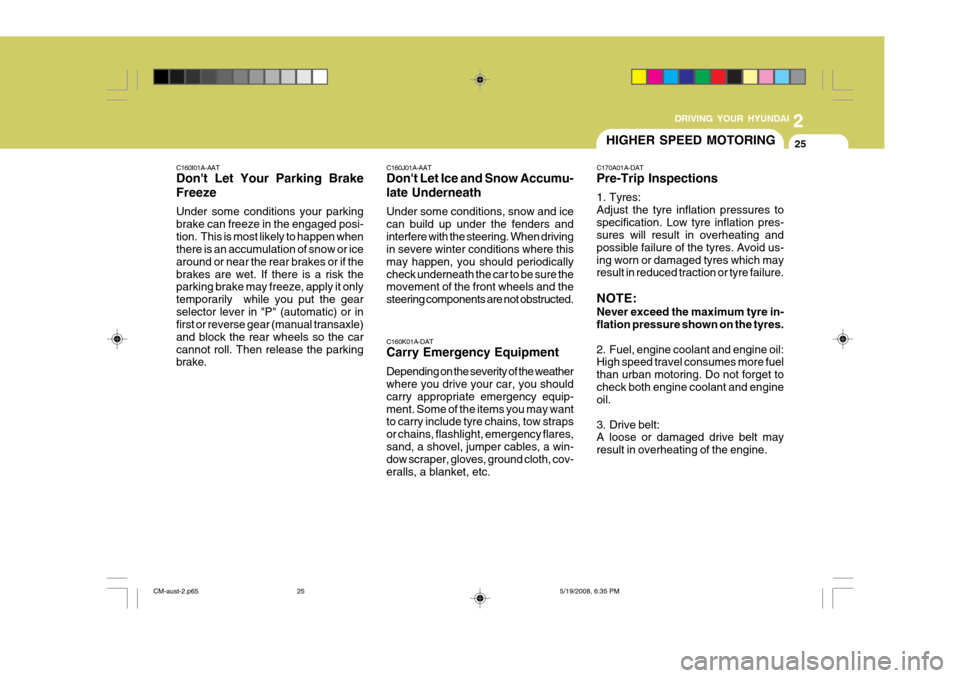
2
DRIVING YOUR HYUNDAI
25
C160J01A-AAT Don't Let Ice and Snow Accumu- late Underneath Under some conditions, snow and ice can build up under the fenders andinterfere with the steering. When driving in severe winter conditions where this may happen, you should periodicallycheck underneath the car to be sure the movement of the front wheels and the steering components are not obstructed. C160K01A-DAT Carry Emergency Equipment Depending on the severity of the weather where you drive your car, you should carry appropriate emergency equip-ment. Some of the items you may want to carry include tyre chains, tow straps or chains, flashlight, emergency flares,sand, a shovel, jumper cables, a win- dow scraper, gloves, ground cloth, cov- eralls, a blanket, etc.HIGHER SPEED MOTORING
C170A01A-DAT Pre-Trip Inspections
1. Tyres: Adjust the tyre inflation pressures tospecification. Low tyre inflation pres- sures will result in overheating and possible failure of the tyres. Avoid us-ing worn or damaged tyres which may result in reduced traction or tyre failure. NOTE: Never exceed the maximum tyre in- flation pressure shown on the tyres.
2. Fuel, engine coolant and engine oil: High speed travel consumes more fuel than urban motoring. Do not forget tocheck both engine coolant and engine oil.
3. Drive belt: A loose or damaged drive belt may result in overheating of the engine.
C160I01A-AAT Don't Let Your Parking Brake Freeze Under some conditions your parking brake can freeze in the engaged posi-tion. This is most likely to happen when there is an accumulation of snow or ice around or near the rear brakes or if thebrakes are wet. If there is a risk the parking brake may freeze, apply it only temporarily while you put the gearselector lever in "P" (automatic) or in first or reverse gear (manual transaxle) and block the rear wheels so the carcannot roll. Then release the parking brake.
CM-aust-2.p65
5/19/2008, 6:35 PM
25
Page 174 of 269
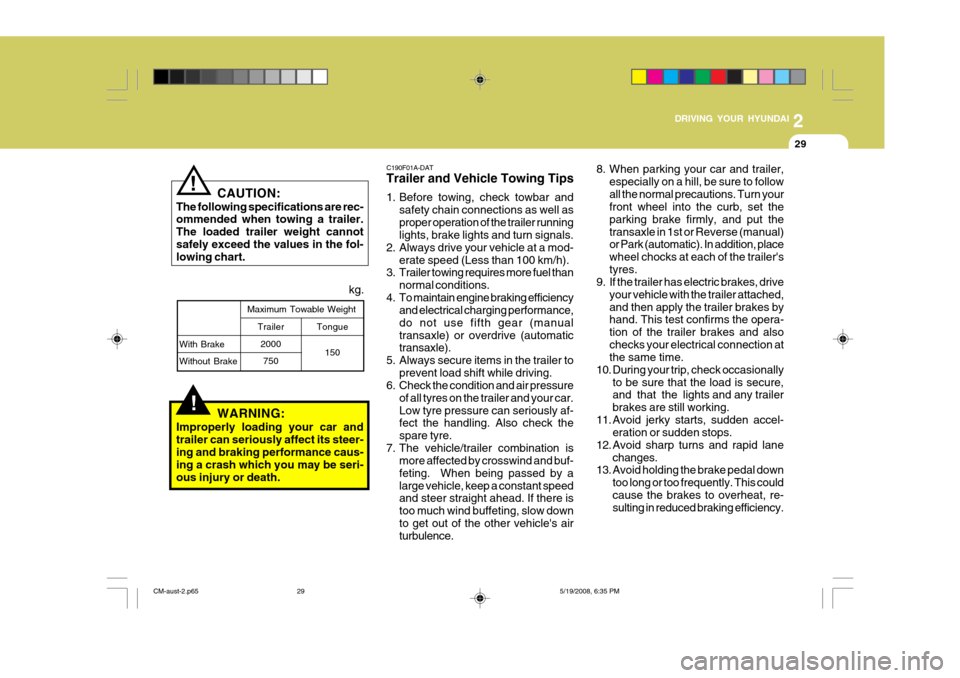
2
DRIVING YOUR HYUNDAI
29
!
C190F01A-DAT Trailer and Vehicle Towing Tips
1. Before towing, check towbar and
safety chain connections as well as proper operation of the trailer running lights, brake lights and turn signals.
2. Always drive your vehicle at a mod- erate speed (Less than 100 km/h).
3. Trailer towing requires more fuel than
normal conditions.
4. To maintain engine braking efficiency and electrical charging performance, do not use fifth gear (manualtransaxle) or overdrive (automatic transaxle).
5. Always secure items in the trailer to prevent load shift while driving.
6. Check the condition and air pressure
of all tyres on the trailer and your car. Low tyre pressure can seriously af- fect the handling. Also check the spare tyre.
7. The vehicle/trailer combination is more affected by crosswind and buf-feting. When being passed by alarge vehicle, keep a constant speed and steer straight ahead. If there is too much wind buffeting, slow downto get out of the other vehicle's air turbulence. 8. When parking your car and trailer,
especially on a hill, be sure to follow all the normal precautions. Turn your front wheel into the curb, set the parking brake firmly, and put thetransaxle in 1st or Reverse (manual) or Park (automatic). In addition, place wheel chocks at each of the trailer'styres.
9. If the trailer has electric brakes, drive
your vehicle with the trailer attached,and then apply the trailer brakes by hand. This test confirms the opera- tion of the trailer brakes and alsochecks your electrical connection at the same time.
10. During your trip, check occasionally to be sure that the load is secure,and that the lights and any trailer brakes are still working.
11. Avoid jerky starts, sudden accel- eration or sudden stops.
12. Avoid sharp turns and rapid lane changes.
13. Avoid holding the brake pedal down
too long or too frequently. This couldcause the brakes to overheat, re- sulting in reduced braking efficiency.
CAUTION:
The following specifications are rec-ommended when towing a trailer. The loaded trailer weight cannotsafely exceed the values in the fol- lowing chart.
!
Maximum Towable Weight kg.
With Brake Without Brake
WARNING:
Improperly loading your car and trailer can seriously affect its steer-ing and braking performance caus- ing a crash which you may be seri- ous injury or death.
Tongue
150
Trailer
2000750
CM-aust-2.p65 5/19/2008, 6:35 PM
29
Page 176 of 269
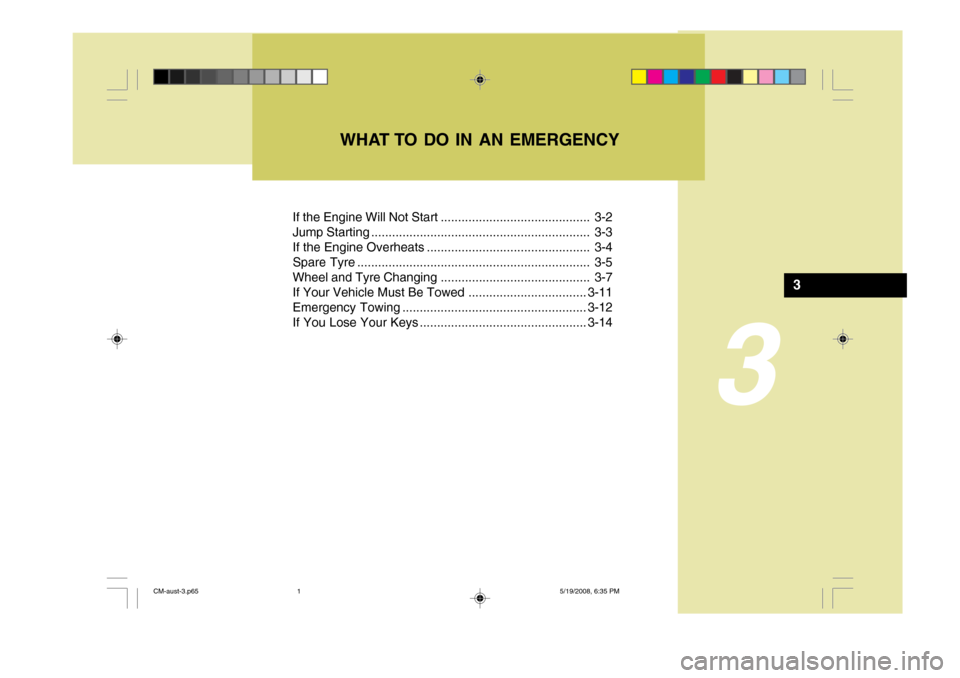
3
If the Engine Will Not Start ........................................... 3-2
Jump Starting ............................................................... 3-3
If the Engine Overheats ............................................... 3-4
Spare Tyre ................................................................... 3-5
Wheel and Tyre Changing ........................................... 3-7
If Your Vehicle Must Be Towed ..................................3-11
Emergency Towing ..................................................... 3-12
If You Lose Your K eys ................................................ 3-14
WHAT TO DO IN AN EMERGENCY
3
CM-aust-3.p65
5/19/2008, 6:35 PM
1
Page 181 of 269
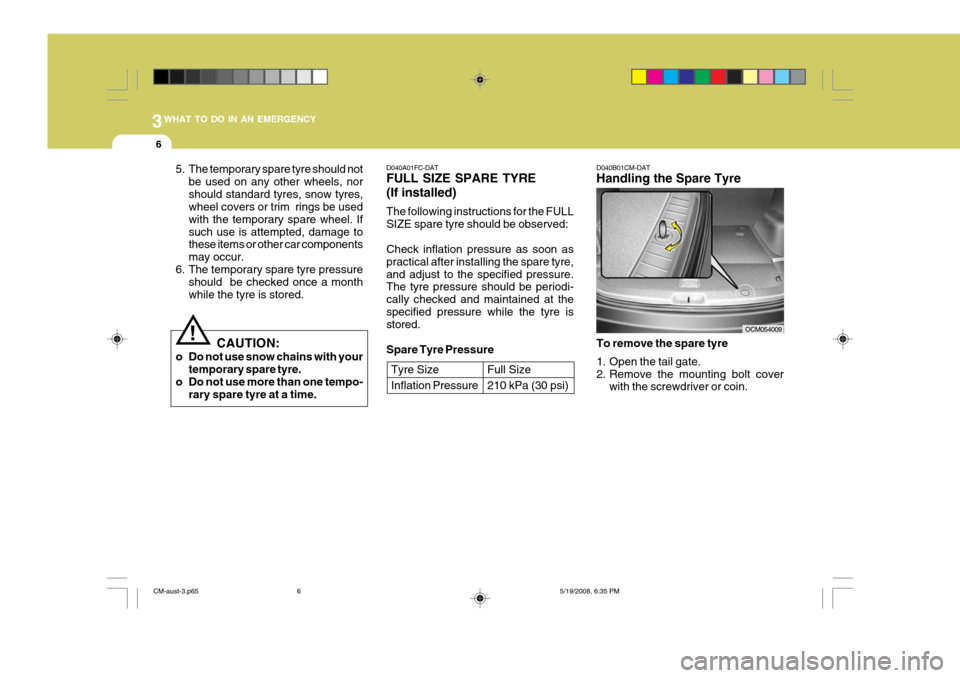
3WHAT TO DO IN AN EMERGENCY
6
D040A01FC-DAT FULL SIZE SPARE TYRE (If installed) The following instructions for the FULL SIZE spare tyre should be observed: Check inflation pressure as soon as practical after installing the spare tyre,and adjust to the specified pressure. The tyre pressure should be periodi- cally checked and maintained at thespecified pressure while the tyre is stored. Spare Tyre Pressure
Full Size 210 kPa (30 psi)
Tyre Size Inflation Pressure D040B01CM-DAT Handling the Spare Tyre
To remove the spare tyre
1. Open the tail gate.
2. Remove the mounting bolt cover with the screwdriver or coin.
OCM054009
5. The temporary spare tyre should not
be used on any other wheels, nor should standard tyres, snow tyres, wheel covers or trim rings be used with the temporary spare wheel. Ifsuch use is attempted, damage to these items or other car components may occur.
6. The temporary spare tyre pressure should be checked once a monthwhile the tyre is stored.! CAUTION:
o Do not use snow chains with your temporary spare tyre.
o Do not use more than one tempo-
rary spare tyre at a time.
CM-aust-3.p65 5/19/2008, 6:35 PM
6
Page 182 of 269
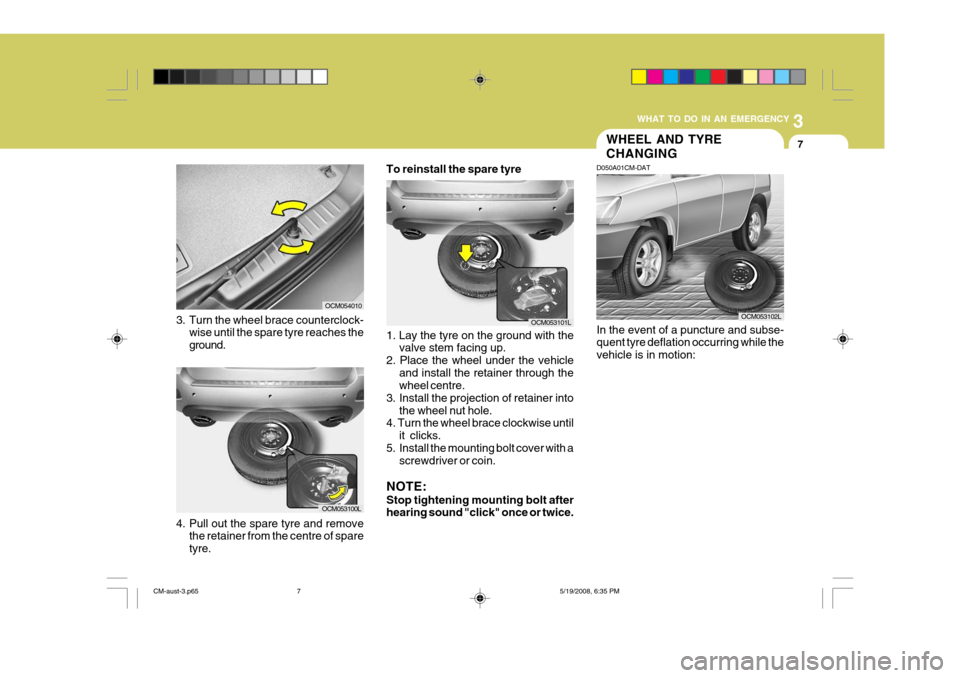
3
WHAT TO DO IN AN EMERGENCY
7
3. Turn the wheel brace counterclock-
wise until the spare tyre reaches the ground.
OCM054010
4. Pull out the spare tyre and removethe retainer from the centre of spare tyre.
OCM053100L
1. Lay the tyre on the ground with thevalve stem facing up.
2. Place the wheel under the vehicle and install the retainer through the wheel centre.
3. Install the projection of retainer into the wheel nut hole.
4. Turn the wheel brace clockwise until
it clicks.
5. Install the mounting bolt cover with a screwdriver or coin.
NOTE: Stop tightening mounting bolt after hearing sound "click" once or twice.
OCM053101L
To reinstall the spare tyre
WHEEL AND TYRE CHANGING
D050A01CM-DAT In the event of a puncture and subse- quent tyre deflation occurring while the vehicle is in motion:
OCM053102L
CM-aust-3.p65 5/19/2008, 6:35 PM
7